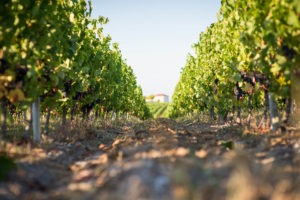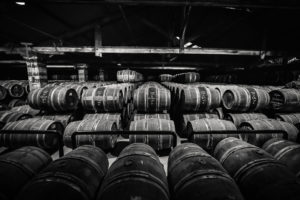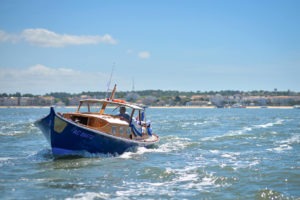Grand Cru Classé, Château Larrivet Haut-Brion is part of the Pessac Léognan appellation.
On the wall is written the name of this famous Cru. A lots of centuries went through this incredible place which has known different names, owners and also different sizes ! Back in the time, the property name was “Château de Canolle”, then “Château La Rivette”, and finally in 1874 it has been baptised “Château Haut-Brion Larrivet”. The vineyard was 50 hectares and will also know a lots of crisis : the First World War, the viticultural crisis in the thirties, the Second World War… Sir Guillemaud, the new owner, tried to renovate the fame of the Château. In 1987, the Château Larrivet Haut-Brion (which is the last name given to the property) is rebought by the famous Gervoson family who is going to carry on what Sir Guillemaud did. In a few years, the property goes from 17 hectares of vines and 13 hectares of park to a total of 72,5 hectares, thanks to the acquisition of 11,5 hectares of white grappes vines and 61 hectares of black grappes vines.
Gervoson, did this name ring to you ? No ? So, if I tell you Andros, do you see what I’m talking about ? Yes, Château Larrivet Haut-Brion is owned by the son’s creator of this well-known fruity products brand. His descendants still manage the property today.
The Œnofolies, which are organized by the Château thanks to Emilie Gervoson, are a good wines and great experiments amateurs meetings. Some priviledged people can be introduced to the Château or to an event in Paris in order to live an incredible moment. Here are the last Œnofolies :
– Œnofolies 1 , June the 25th of 2011 between the Cap Ferret and Léognan in Bordeaux area : Between Earth & Sea, an exploration and an amazing degustation…
– Œnofolies 2, November the 22nd of 2011 in Paris : Château Larrivet Haut-Brion met Ruinart and Caviar to “Play with the palate”…
– Œnofolies 3, February the 14th of 2012 in Paris : Artistic Wine or Inebriating Art ?
– Œnofolies 4, November the 17th of 2012 in Léognan (Bordeaux area) : The underwater aging, myth or reality ?
I’ve been to this last one, it’s my article’s topic !
“Exception, Delight, Exploration“
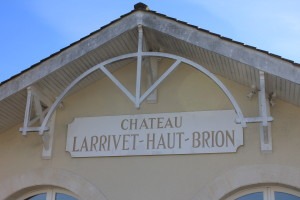
We were an average of twenty people to assist to this tasting. Welcomed by Emilie Gervoson, the owner’s first daughter, ambassador and creator of the Œnofolies, we have taken an amazing sun bath before beginning the cellar visit with Bruno Lemoine, the General Manager.
Bruno Lemoine, enthusiast, told us how the idea of this last Œnofolie is born. During a lunch with Pierre-Guillaume Chiberry – Radoux Cooper, Joël Dupuch – the actor and oyster farmer and himself, they talked about the famous Marquis d’Estournel who was sending wines in India during the XVIII century. The wines which weren’t sold went back in Bordeaux but curiously they were well better ! Then the idea was born : some months later a barrel (produced by the Radoux Cooper for sure) was put in the Joël Dupuch oysters park. They really wanted to know if this theory was true and compared an underwater aging wine between winds and high waters with a cellar aging wine in a perfect balanced universe.
“Put some water in wine“
Twenty centuries ago, Lucius Columelle, a roman agronomist, advised to put some sea water in wine. It was trendy to add some water or sea water in your drinks to add sweetness and to increase the flavors. History puts the ocean in the center of wines myth with some magical discoveries like Titanic bottles or Champagne bottles in the Baltic Sea (a 170 years old Veuve Clicquot bottle has been sold 78 400 dollars during an auction), but also greek or roman amphoras in the Mediterranean Sea.
Studies has been conducted in South America but also in the spanish Bask Country in order to seek the mystery. Today, some men, pushed by the curiosity, want to know if it’s the reality or just want to attract consumers. It’s not seldom to meet wineries which aged their wines in amphoras like the Clos Romain, or Château Du Coureau which aged its Grave Blanc des Cabanes in the Bassin d’Arcachon or Emmanuel Poirmeur who age its wine Egiategia in concrete vats in the Saint-Jean-de-Luz bay. There are many other foodie exemples but only one Grand Cru Classé of Bordeaux tried this experiment… Verdict: the underwater aging is no more a myth for those who tasted it…
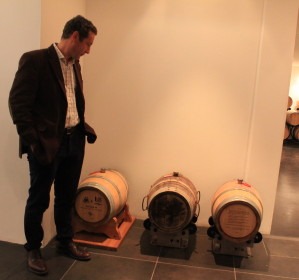
Introducing the 3 little barrels by Pierre-Guillaume Chibérry of Radoux Cooper : the 3 barrels of 56 liters have been created in oak wood with a classical toast as the barrels we can find in the Château cellar. The first little barrel should have been doing a trip around the world : destiny wanted to do it differently during the River Party of Bordeaux, the boat on which the barrel was, did 500 meters before hit a sandbank. Then the project has been given up. The second barrel has been put in Joël Dupuch oysters park during an average of 6 months. The last little barrel is the one where the wine stayed 6 months extra in the Château cellar. These barrels have been custom-made with special innox corcks and have been sealed in presence of a bailiff.
The 3 little barrels have been filled with the same vintage : 2009, exceptionnal year in Bordeaux.
In February 2012, the barrels have been unsealed to face examinations in the Michel Rolland Laboratory, specialized in wine analysis. Then a tasting has been done with the famous taster Bernard Burstchy. In front of the astonishing conclusion, it has been decided that some priviledged people will taste the wine during an Œnofolie. With 56 liters for one barrel, 20 magnums and 20 bottles have been filled. To continue the experiment, most of the magnums and bottles are going to be preserved and tasted to see the evolution !
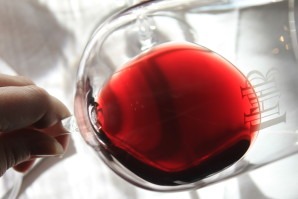
– Château Larrivet Haut-Brion, Pessac Léognan 2009.
Beautiful ruby limpid and shiny, this Château Larrivet Haut-Brion 2009 is full of promises. The first nose is delicate and fresh with a note of mint. The fruit is compelling as raspberry which is very present. There are also some very nice sweet spices. The second nose is also delicate. Woody flavors mix perfectly with the unity. The mouth is notchy, fresh with cocoa, fruits (cherry and raspberry) but also a light wood touches. The finish is refined but also powerfull. A beautiful wine to keep.
– Château Larrivet Haut-Brion, Tellus(6 months extra in barrels), Pessac Léognan 2009.
The wine stayed 6 months extra in oak barrel. This has not influenced its color which is a seductiv ruby ! The first nose is really fresh but seems to be more woody with notes of prune. The second nose let appear a note of mint with a nice balance between wood and fruit. The mouth is supple with mint and kirsh. Tanins are also smooth with a light astringency in the finish. Flavors of liquorice, cocoa and stewed fruits are very nice et let an amazing finish on raspberry. More dried than the ‘normal’ 2009, it is still delicate and will have a nice evolution… This wine is full-bodied with power.
– Château Larrivet Haut-Brion, Neptune(6 months underwater), Pessac Léognan 2009.
Then, the most important wine I wanted to taste !! Château Larrivet Haut-Brion ‘Neptune’ which lived 6 months in the Bassin d’Arcachon : most of the time, the barrel was underwater but has also known a little bit of air. The color of this wine is as brilliant as the two others, ruby, maybe a little bit more on evolution but still full of intensity. But the nose is really different : more smooth, more supple on stweded fruits. The second nose is kirshy maybe balsamic. There is still an incredible freshness but the nose is sweeter and less agressiv. The mouth is velvet with red fruits and black fruits flavors with some spicies. Less bitter than the two others, the finish has got silky tanins on the fruit. A nice salty impression stays in mouth…
The fact to have lived an underwater aging allowed a polymerization of the tanins (they are softer), but also a salinisation (80mg/L of sodium) thanks to a penetration by osmose of salt in the wood. The salt is flavor enhancer, then the wine seems nicer. Moreover,the classical Château Larrivet Haut-Brion has got 14,2% alcohol against 13,6% for Neptune after its aging in the Bassin d’Arcachon.
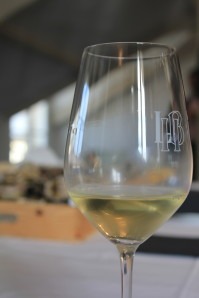
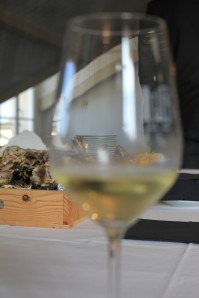
“I love oysters : it’s like kissing the sea on its lips.“
To finish on a nice note, the Château forcasted a tasting of its second white wine with the famous oysters of Joël Dupuch. Smooth in the mouth, Les Demoiselles de Haut-Brion (name given in honor of the 3 owner’s daughters) is a dry white fresh wine, nice, fruity and woody. Perfect match with oysters naturally !

